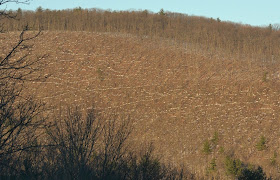I've already posted about the flock of Evening Grosbeaks that visited our feeders in early December. Those fantastic birds stayed around for four days, and then they moved on for good. (I wonder how many years it will be before I see another Evening Grosbeak.) Just a week later, though, on December 13, we had another surprise at our feeders when a single Common Redpoll showed up:
I haven't seen a Common Redpoll since I came across a small flock of these little finches at the Connecticut shore in 2013. These birds certainly aren't common around here, and my understanding is that it's quite special to have one visit your feeder. Either way, I was delighted to meet this streaky brown-and-white creature, with its pointy yellow beak and perfect little red cap:
The redpoll seemed to thoroughly enjoy the nyjer seeds at our feeder:
While I watched the redpoll, I also had the opportunity to see one of the Meadow Voles that had taken to boldly foraging under the feeders around that time (I haven't seen these creatures outside of their burrows beneath the snow in a while, but there was a span of a couple of weeks when we saw them frequently in the open and munching on dropped seeds) -- look at this cute little rodent face:
The redpoll stayed around for a few hours and then moved on. I'm happy to host these rare northern visitors in our yard, even if only for a little while!
On the morning of January 14, a layer of ice on twigs and branches made for some amazing sights in our meadow:
Perfectly ice-coated treetops made for quite a view through a telephoto lens:
Even an old spider web outside our kitchen window was beautifully highlighted by frost and sunlight:
By a couple of hours later, the sun had melted much of the ice, and this male Red-bellied Woodpecker looked very pretty in his sunlit apple tree:
The half-melted landscape was in some ways even more interesting than the fully iced version of two hours earlier:
On January 27, I wandered through our snow-covered meadow and admired the intricate patterns of dead flower stems -- many of them from seeds we planted -- against the pristine snow:
These Black-eyed Susan blooms were strangely pretty from above:
I love the graceful shape (and reddish color) of this Little Bluestem stalk:
And these Common Yarrow stalks made interesting shapes against the snow:
While walking in our woods on February 2, I came across the signs of what seemed to be a rabbit festival, with more rabbit droppings than I think I've ever seen in one area, as well as -- this is new to me -- spots of shockingly red pee:
The next day (February 3), a walk in the woods turned up a spider -- what a robust creature this must be, to be out and about in February, with snow still on the ground:
This Blue Jay perfectly matched its gray-branch and blue-sky surroundings:
A Dark-eyed Junco sang quietly from within a sun-lit bush (practicing its song for breeding season?) and then emerged long enough to have its portrait taken:
An American Tree Sparrow also made an appearance:
This is such a handsome sparrow, especially against the clear blue sky:
I stopped to admire (as I do every time I pass by) the fuzz-tipped buds of this Allegheny Serviceberry tree I planted last year:
At another edge of the meadow, I was surprised to see the incredible amount of old Yellow-bellied Sapsucker holes on this very old apple tree, and just as surprised that I'd never noticed all these holes before now:
The afternoon light perfectly set off some big pine trees on the wooded ridge across the street from our house:
On February 21, a temporary thaw and bright sunlight brought out a cobweb-like tracing of snowy remnants on the hills across the valley:
As I write this on February 25, we're getting frigid winds and fresh snow, and it certainly still feels like winter. But changes are happening: the daylight is getting noticeably stronger and longer, the cardinals and chickadees have started singing in recent weeks, and I even spotted some crocus leaves emerging from the ground way back on February 10. I know that March will bring more tantalizing signs of the coming spring, and I'm excited to see what will happen during this year's more active seasons.



























This comment has been removed by a blog administrator.
ReplyDelete